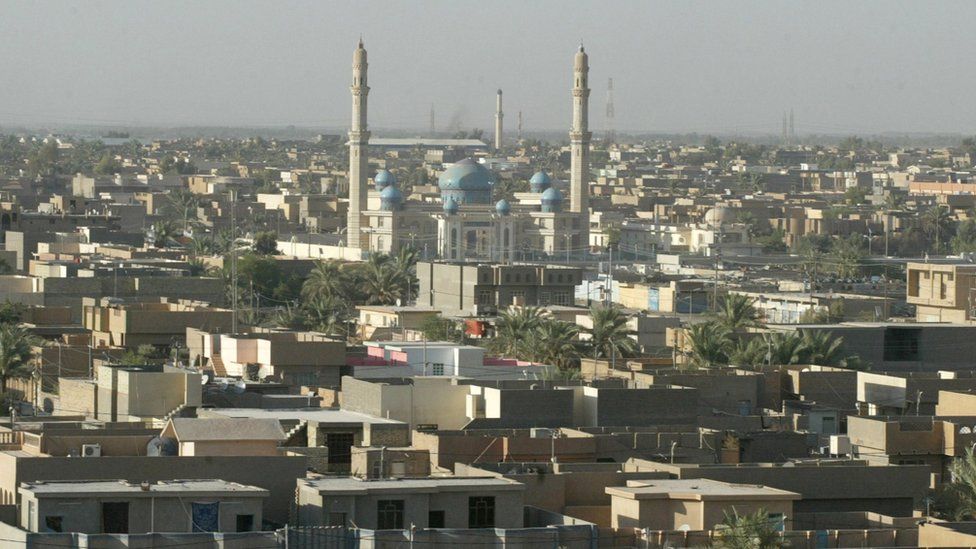Falluja: Embattled city of mosques
- Published

Falluja, a predominantly Sunni Arab city about 65km (40 miles) west of the Iraqi capital, Baghdad, has long been an insurgent stronghold.
The US military fought two battles in the city in 2004 in an attempt to drive out al-Qaeda militants and others opposed to its occupation of the country.
Ten years later, fighters from so-called Islamic State (IS) seized control of Falluja amid mass protests by local Sunnis against the Shia-led government's sectarian policies.
At the end of May 2016, Iraqi security forces and pro-government militiamen closed in on the city, in an attempt to take it back.
Contractors killed
Falluja, known within Iraq as "the city of mosques", was religiously conservative before the US-led invasion in March 2003 that toppled Saddam Hussein.
It was one of many places where Islamists moved in when Saddam's Sunni Arab-dominated regime fell and its social control networks were dismantled.
Elliott Ackerman recalls fighting in the Battle of Fallujah
Falluja became increasingly hostile to the occupation and US troops were involved in deadly clashes with protesters as early as April 2003.
Growing violence over the next year led the US to withdraw its forces from within the city, while former regime loyalists and jihadists were allowed to base themselves there by religious and tribal leaders.
In March 2004, four American civilian contractors from the firm Blackwater were killed by gunmen as they drove into the centre of Falluja.
Their bodies were later mutilated and burned. One was hung from a bridge over the River Euphrates. Video footage of the attack was broadcast around the world.
The US Marines were ordered by then President George W Bush's administration to wrest control of the city and root out insurgents.
However, they quickly got bogged down as Falluja residents rose up to defend their city, while the mounting civilian casualties triggered protests and attacks elsewhere in Iraq.
Within days, a ceasefire was agreed. The US withdrew its forces to the outskirts of Falluja, which became a stronghold for insurgents, including jihadist militants from al-Qaeda in Iraq (AQI).
Birth defects
That November, some 12,000 US Marine and Army personnel and 2,500 Iraqi troops launched a major assault to drive out the estimated 4,000 rebels believed to be inside the city.
The troops gained control of Falluja within a week, although sporadic fighting continued into December.
More than 80 US troops were killed in the battle, along with an estimated 2,000 insurgents.
Thousands of buildings, including almost 60 of the city's 200 mosques, were also destroyed and most of its 300,000 residents were displaced.
Human rights groups accused the US military of using excessive force and condemned its use of white phosphorous munitions.
The US argued that its use was legal because civilians, it said, were not targeted.
Falluja remained restive in the years that followed, with anger and resentment towards the US occupation building.
Reconstruction was slow and doctors also reported high levels of birth defects, with some blaming the weapons used by the US.
However, AQI's hold on Falluja was steadily weakened by a US troop "surge" in 2007 and the creation of Sahwa (Awakening) councils by Sunni Arab tribesmen who rejected its brutality and took up arms to battle the jihadist group.
Protest camps
After the withdrawal of US forces in 2011, AQI's successor organisation Islamic State in Iraq (ISI) was able to start rebuilding itself and the number of attacks increased.
ISI also joined the rebellion against President Bashar al-Assad in neighbouring Syria, seizing large swathes of territory, acquiring weaponry and attracting foreign recruits.
In 2013, the group renamed itself Islamic State in Iraq and the Levant (Isis) and exploited a political stand-off between Iraq's Shia-led government and Sunni Arab community, whose members complained that they were being targeted in the name of combating terrorism.
In early January 2014, after Prime Minister Nouri Maliki ordered security forces to dismantle protest camps that had existed for more than a year, Isis militants overran Falluja and much of Ramadi with the help of local tribesmen and Saddam loyalists.
Six months later, Isis seized control of the second city of Mosul and much of northern and western Iraq. It then declared the creation of a caliphate and changed its name to Islamic State.
Iraqi security forces, Shia militias and Sunni tribal fighters besieged Falluja and its suburbs for several months before launching an operation to "liberate" the city.
The UN has expressed serious concern for the safety of the 50,000 civilians estimated to be inside Falluja, who have faced acute shortages of food, medicine and other essential items.
The Iraqi military has urged all civilians to leave Falluja and instructed those unable to escape to raise a white flag.